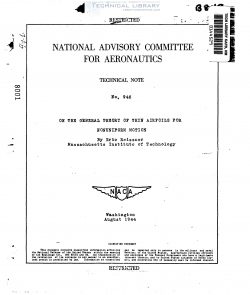naca-tn-946
- Version
- 142 Downloads
- 1.94 MB File Size
- 1 File Count
- December 1, 2016 Create Date
- December 1, 2016 Last Updated
National Advisory Committee for Aeronautics, Technical Notes - On the General Theory of Thin Airfoils for Nonuniform Motion

General thin—airfoil theory for a compressible fluid
is formulated as boundary yroblem for the velocity poten—
tial, without recourse to the theory of vortex motion.
On the basis of this formulation the integral aqua.
tion of lifting—surface theory for an incompressible fluid
is derived with the chordwise component of the fluid ve—-
locityat the airfoil as the function to be determinedg_ It
is shown how by integration by parts this integral equation
can be transformed into the BiOt—Savart theorem. A clari—
fication is gained regarding the use of principal value
definitions for the integrals which occur.
The integral equation of lifting—surface theory is
used as the starting point for the establishment of a theory
for the nonstationary airfoil which is a generalization of
lifting—line theory for the stationary airfoil and which
might be called "lifting—strip" theory. Explicit exPres_
sions are given for section lift and section mement in terms
of the circulation function, which for any given wing de-
flection is to be determined from an integral equation which
is of the type of the equation of lifting-line theory. The
results obtained are for airfoils of uniform chord They
oan be extended to tapered airfoils_ One of the main uses
of the results should be that they furnish a practical means
for the analysis of the aerodynamic span effect in the problem
of wing flutter The range of applicability of "liftingn
strip" theory is the same as that of 1ifting~line theory so
that its results may be applied to airfoils with aspect ratios
as lbw as three.
The theory of thin airfoils may be characterized by
the statement that it is the linear theory, obtained through
simplifications from an exact formulation of airfoil theory
for a nonviscous fluid. It is based on the assumptions of
infinitely thin airfoil sections, infinitesimal angle of
attack,end infinitesimal camber. In spite of these restric~
tivc aesumptions it is plausible and generally accepted that
the theory reproduces the characteristic behavior of actual
wings with finite angle of attack and camber rather accurately
in many practical problems.
First contributions to the theory of thin airfoils are
Prandtl's theory of the lifting line (reference 1) for the
determination of the aerodynamic span effect for stationary
airfoils of not too small aspect ratio, and Munk‘s two—
dimensional theory of stationary airfoils (reference 2).
| File | Action |
|---|---|
| naca-tn-946 On the General Theory of Thin Airfoils for Nonuniform Motion.pdf | Download |

Comment On This Post